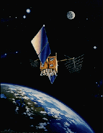
"Normal" satellite navigation receivers compare a pseudorandom signal being sent from the satellite with an internally generated copy of the same signal. Since the signal from the satellite takes time to reach the receiver, the two signals do not "line up" properly, the satellite's copy is delayed in relation to the local copy. By progressively delaying the local copy more and more, the two signals will eventually line up properly. That delay is the time needed for the signal to reach the receiver, and from this the distance from the satellite can be calculated.
The accuracy of the resulting range measurement is generally a function of the ability of the receiver's electronics to accurately compare the two signals. In general receivers are able to align the signals to about 1% of one bit-width. For instance, the C/A signal sent on the GPS system sends a bit every 1/10th of a microsecond, so a receiver is accurate to 1/100th of a microsecond, or about 3 metres in terms of distance. The military-only P(Y) signal sent by the same satellites is clocked ten times as fast, so with similar techniques the receiver will be accurate to about 30 cm. It is important to note that other effects introduce errors much greater than this, and accuracy based on an uncorrected C/A signal is generally about 15 m.RTK follows the same general concept, but uses the satellite's carrier as its signal, not the messages contained within. The improvement possible using this signal is potentially very high if one continues to assume a 1% accuracy in locking. For instance, the GPS C/A signal broadcast in the L1 signal changes phase at 1.023 MHz, but the L1 carrier itself is 1575.42 MHz, over a thousand times faster. This corresponds to a 1% accuracy of 19 cm using the L1 signal, and 24 cm using the lower frequency L2 signal.The difficulty in making an RTK system is properly aligning the signals. The navigation signals are deliberately encoded in order to allow them to be aligned easily, whereas every cycle of the carrier is similar to every other. This makes it extremely difficult to know if you have properly aligned the signals, or are "off by one" and thus introducing an error of 20 cm or a larger multiple of 20 cm. This integer ambiguity problem can be addressed to some degree with sophisticated statistical methods that compare the measurements from the C/A signals and by comparing the resulting ranges between multiple satellites. However, none of these methods can reduce this error to zero.In practice, RTK systems use a single base station receiver and a number of mobile units. The base station re-broadcasts the phase of the carrier that it measured, and the mobile units compare their own phase measurements with the ones received from the base station. This allows the units to calculate their relative position to millimeters, although their absolute position is accurate only to the same accuracy as the position of the base station. The typical nominal accuracy for these dual-frequency systems is 1 centimetre ± 2 parts-per-million (ppm) horizontally and 2 centimetres ± 2 ppm vertically.
Although this limits the usefulness of the RTK technique in terms of general navigation, it is perfectly suited to roles like surveying. In this case, the base station is located at a known surveyed location, often a benchmark, and the mobile units can then produce a highly accurate map by taking fixes relative to that point. RTK has also found uses in autodrive/autopilot systems, precision farming and similar roles.

